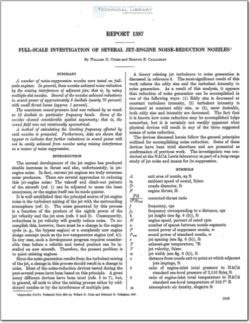NACA-Report-1387

- Version
- 95 Downloads
- 2.00 MB File Size
- 1 File Count
- December 4, 2015 Create Date
- December 4, 2015 Last Updated
National Advisory Committee for Aeronautics, Report - Full Scale Investigation of Several Jet Engine Noise Reduction Nozzles

A number of noise-suppression nozzles were tested on fall—
scale engines. In general, these nozzles achieped noise reduction
by the mixing interference of adjacent jets; that is, by using
multiple-slot nozzles. Several of the nozzles achieved reductions
in sound power of approximately 5 decibels (nearly ’70 percent)
with small thrust losses (approx. 1 percent).
The maximum sound-pressure level was reduced by as much
as 18 decibels in particular frequency bands. Some of the
nozzles showed considerable spatial asymmetry; that is, the
sound field was not rotationally symmetrical.
A method of calculating the limiting frequency ejected by
such nozzles is presented. Furthermore, data are shown that
appear to indicate that further reductions in sound power will
not be easily achieved from nozzles using mixing interference
as a means of noise suppression.
The normal development of the jet engine has produced
sizable increases in thrust and also, unfortunately, in jet—
cngine noise. In fact, current jet engines are truly awesome
noise producers. There are several approaches to reducing
this jet-engine noise: The takeoff and climb-out pattern
of the aircraft (ref. 1) can be adjusted to cause the least
annoyance, or the engine itself can be made quieter.
It is well established that the principal source of jet-engine
noise is the turbulent mixing of the jet with the surrounding
atmosphere (ref. 2). The noise generated by this process
is a function of the product of the eighth power of the
jet velocity and the jet area (refs. 2 and 3). Consequently,
reductions in jet velocity will greatly reduce noise. To ac-
complish this, however, there must be a change in the engine
cycle (e. g., the bypass engine) or a completely new engine
design concept (such as the low-temperature engine (ref. 4)).
In any case, such a development program requires consider— '
able time before a reliable and tested product can be in-
stalled on new aircraft. Therefore, the present problem is
to quiet existing engines.
| File | Action |
|---|---|
| naca-report-1387.pdf | Download |

Comment On This Post